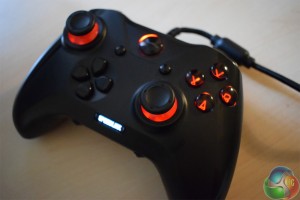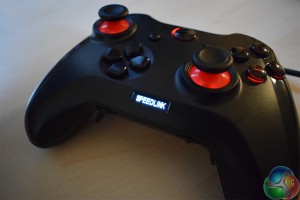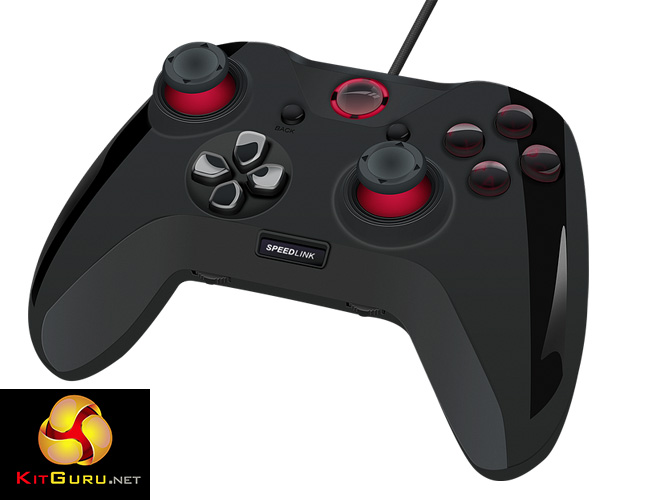To test the SpeedLink Quinox, I used it as my primary gaming controller, using it across a number of games to get a feel for how it plays and controls.
First, let's look at some of the customisation options available to each user. All the customisable settings are accessed by using the two small flick switches on the front of the gamepad. By pressing these buttons down and then scrolling through the on-screen options using the D-pad, users can control things like analog stick sensitivity as well as choose between 1 of 2 profiles.
You can even record macros and assign them to any of the K buttons – the four buttons on the back, as well as an extra 2 on the shoulder of the gamepad. I must say this could be quite handy depending on the game you are playing – having the ability to customise profiles to suit different game genres saves you having to adjust the settings every time you play a new game, for instance.
You can also adjust the red backlight using the flick switches – though it can only be ‘on' or ‘off' as there is no brightness control. Personally, I found the backlight to be very distracting when playing games, so I quickly turned it off – but that is merely my personal preference. In the above images you also get a look at the OLED display, which displays the ‘SpeedLink' name when you are not adjusting any of the gamepad's settings.
Moving on to the physical usage of the gamepad, I will start by mentioning the build quality. While I would not say the Quinox feels ‘cheap' when you are holding it, it does not have the reassuring sturdiness of the Xbox 360 controller, for instance. What I mean is, it is just a bit too light for my liking – it almost feels a bit hollow. I could imagine myself someone being able to break it in a moment of rage, too, more so than the Xbox 360 controller at least.
I must also admit I found the 4 additional rear buttons troublesome. Firstly, I just never found myself needing to use them. The games I play with a controller are usually sports and racing titles – FIFA and GRID – to give two examples. When playing these games in the past (I usually use a wireless Xbox 360 controller) I have never once wished I had an extra 4 buttons, so when I began using the Quinox I used them very rarely. This is a personal thing – you may well be frustrated with the lack of buttons on your gamepad of choice, in which case the Quinox could be a good option for you. However, I just did not find myself needing the extra buttons.
Because of that, I got a bit frustrated with those 4 buttons simply because they were there. What I mean is, when holding the Quinox, your fingers naturally rest on top of those 4 rear buttons. In practice, I found this meant I was not gripping the gamepad as hard as I would usually, as I did not want to accidentally trigger one of those buttons. As such, I had to compensate by gripping more firmly on the sides of the gamepad, using the middle of my palms. This led to my hands getting a bit sore after a while, which is never ideal.
My final gripe with the Quinox stems from the analog sticks' rubber coating. As with most gamepads, the top of each analog stick has an indent for you to rest your thumbs while gaming. However, SpeedLink have coated the indents with a very smooth rubber, which meant my thumbs could never grip properly and kept slipping – the surface felt almost greasy, and I actually kept wiping my hands at first because I thought I was just perspiring. I wasn't, though, and the analog sticks were definitely to blame. I think a textured finish would have been a much smarter move here, as the friction would help you grip better. After all, no one wants their thumb to slip at a crucial moment in-game.
The rest of the gamepad did not pose me any problems, though. I actually particularly liked the tactile action from the two bumper switches as I found these buttons to be more responsive and satisfying to click when compared with my Xbox 360 controller. The braided, detachable cable is also a nice touch, making it a little easier to transport the Quinox since you do not have to wrap the cable around the gamepad – rather, you can quickly unplug it and fold it neatly to prevent any kinks.
All-in-all, though, the SpeedLink Quinox is not for me. My biggest issue is subjective, but I just find the extra rear buttons to be unnecessary – they actually got in the way of my gaming experience. Add that to the lightweight build of the gamepad, as well as the slippery analog sticks, and I will be sticking with the Xbox 360 controller.
That being said, the Quinox could be a good bet for a different type of gamer. The customisation options are certainly useful, so if you want extra buttons and functionality over a more standard gamepad, the Quinox is worth considering.
It does cost a fair bit, coming in at £48.80 inc. VAT from CCL over HERE. If you are the type of gamer who would use the extra functions and customisable options it probably sounds like a better deal to you than it does to me. However, when you consider that a wireless Xbox 360 controller is only around £30-35 on Amazon, I know what I would rather spend my money on.
Pros
- Lots of settings can be customised
- Braided cable.
- Extra buttons could be useful for some.
Cons
- Build quality is slightly lacking.
- Analog sticks do not grip well.
- Rear buttons prevent a firm grip.
KitGuru says: There are a lot of extra features packed in to the Quinox which may appeal to you, but the extra buttons prevented me from griping the gamepad as firmly as I would like, and the build quality is slightly lacking.
Be sure to check out our sponsors store EKWB here
 KitGuru KitGuru.net – Tech News | Hardware News | Hardware Reviews | IOS | Mobile | Gaming | Graphics Cards
KitGuru KitGuru.net – Tech News | Hardware News | Hardware Reviews | IOS | Mobile | Gaming | Graphics Cards






